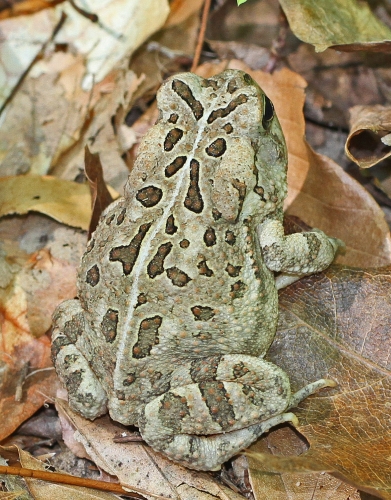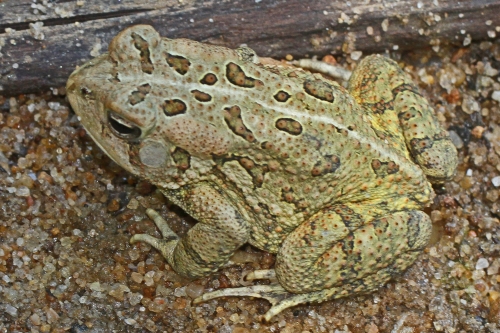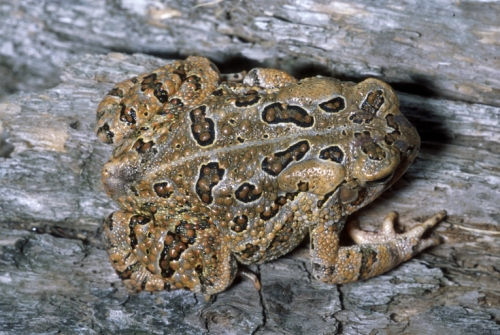Plants and Animals
Anaxyrus fowleri Fowler's toad
Key Characteristics
The Fowler’s Toad is fairly small, with adult lengths of 5.1 to 9.4 cm. Like all toads, they have dry, warty skin with short legs. They are usually brown, gray, or olive green in color (occasionally with some red or yellow) and have black-edged dark spots on their backs, with a light stripe down the middle of the back. This toad can be distinguished from the American Toad (Anaxyrus americanus) by the presence of at least 3 warts within each dark spot on its back although this can vary (American toads generally have 3 or less). The underside of the Fowler’s Toad is white or cream colored and is almost completely unspotted or with a single dark spot between the forelimbs and the lower leg (tibia) has no enlarged warts. In contrast, the American Toad has dark spots or blotches on its underside and enlarged warts on its lower leg. The breeding call of the Fowler's Toad sounds like a bleating sheep or “shrill scream” lasting from one to four seconds, whereas the American Toad’s breeding call is a prolonged musical trill.
Status and Rank
US Status: No Status/Not Listed
State Status: SC - Special Concern (rare or uncertain; not legally protected)
Global Rank: G5 - Secure
State Rank: S3S4 - Rank is uncertain, ranging from vulnerable to apparently secure
Occurrences
| County | Number of Occurrences | Year Last Observed |
|---|---|---|
| Allegan | 1 | 2022 |
| Barry | 1 | 2006 |
| Kent | 3 | 2017 |
| Mason | 3 | 2022 |
| Muskegon | 1 | 2019 |
| Oceana | 2 | 2021 |
| Ottawa | 1 | 2021 |
Information is summarized from MNFI's database of rare species and community occurrences. Data may not reflect true distribution since much of the state has not been thoroughly surveyed.
Habitat
Fowler’s Toads are closely associated with habitats that have deep, loose, sandy or gravelly soil in which they can easily burrow. These habitats include open woodlands, meadows, sand prairies, beaches, dunes, sandy lakeshores, river valleys, and floodplains. They also can be found in agricultural and residential areas including gardens, yards, fields, pastures, roadsides, and ditches. During drought or hot, dry periods and in the winter, they burrow underground (below the frost line to just above the water table during the winter) or hide under rocks, plants, or other cover. They breed in warm shallow waters that are fairly open including temporary or vernal pools, marshes, permanent ponds, farm ponds, roadside ditches, lakeshores, slow-moving streams, river floodplains or backwaters, sloughs, pools between dunes or along beaches, shallow bays, and other flooded low areas or bodies of water lacking a strong current.
Natural Community Types
- Coastal plain marsh
- Dry sand prairie
- Dry southern forest
- Dry-mesic northern forest
- Dry-mesic prairie
- Dry-mesic southern forest
- Emergent marsh
- Floodplain forest
- Great lakes barrens
- Great lakes marsh
- Interdunal wetland
- Intermittent wetland
- Inundated shrub swamp
- Lakeplain oak openings
- Lakeplain wet prairie
- Lakeplain wet-mesic prairie
- Mesic northern forest
- Mesic sand prairie
- Mesic southern forest
- Oak barrens
- Oak openings
- Oak-pine barrens
- Open dunes
- Pine barrens
- Sand and gravel beach
- Southern wet meadow
- Submergent marsh
- Wet-mesic sand prairie
- Wooded dune and swale complex
For each species, lists of natural communities were derived from review of the nearly 6,500 element occurrences in the MNFI database, in addition to herbarium label data for some taxa. In most cases, at least one specimen record exists for each listed natural community. For certain taxa, especially poorly collected or extirpated species of prairie and savanna habitats, natural community lists were derived from inferences from collection sites and habitat preferences in immediately adjacent states (particularly Indiana and Illinois). Natural communities are not listed for those species documented only from altered or ruderal habitats in Michigan, especially for taxa that occur in a variety of habitats outside of the state.
Natural communities are not listed in order of frequency of occurrence, but are rather derived from the full set of natural communities, organized by Ecological Group. In many cases, the general habitat descriptions should provide greater clarity and direction to the surveyor. In future versions of the Rare Species Explorer, we hope to incorporate natural community fidelity ranks for each taxon.
Management Recommendations
Maintaining, protecting, and restoring suitable upland habitats and wetland breeding habitats are critical for conserving extant populations of Fowler’s Toads. Avoid or reduce development, intensive recreational use of beach and dune habitats (e.g., by off-road vehicle use), and other activities that decrease or disturb habitat (e.g., beach grooming, shoreline protection measures that can change sand drift and deposition processes and reduce sediment delivery to the shoreline, and wetland drainage). Efforts to control or reduce vegetative succession and invasive species (e.g., Phragmites in wetlands) also would help maintain suitable upland and wetland habitats for this species. Maintaining connectivity between upland and wetland habitats and between populations is critical for supporting the species’ different life history requirements and long-term population persistence and resilience. Minimizing pollution and maintaining vegetated buffers around occupied habitats are critical as Fowler’s toads are known to be susceptible to chemicals for agriculture and mosquito control and heavy metal contaminants. Populations also may be susceptible to predation (e.g., from raccoons, especially in smaller populations in developed areas) and road mortality. Efforts to obtain information on the species’ current status and distribution, population sizes or abundance, ecology, and site-specific threats and management needs, particularly regarding the impact of pollution/chemicals, also are needed.
Active Period
Active from fourth week of April to second week of October
Breeding from fourth week of April to fourth week of June
Survey Methods
Effective methods for surveying this species include breeding call surveys and visual encounter surveys. Breeding call surveys consist of listening for calls of adult males in the evening and at night (i.e., from sunset to 12:00 or 1:00 am) during the breeding season. Calling may begin as early as late April or early May but typically peaks in late May and June, often after heavy rains. Fowler’s Toads typically breed later and at warmer temperatures compared to American Toads. Call surveys should be conducted on multiple nights during the breeding season and should be conducted during appropriate weather conditions. Humidity and cloud cover are not critical, but a sudden drop in air temperature will cause most toads to stop calling. Visual surveys can be conducted during the active period, especially during the breeding season, during and immediately following rain events, and on humid summer evenings/nights. These surveys consist of surveyors walking slowly through suitable habitat, overturning cover objects (e.g., logs/woody debris, rocks, etc.), inspecting retreats, and looking for individuals on the surface or under cover. Night road cruising (i.e., surveying while driving slowly or walking along roads at night) during and immediately after rains in summer and using drift fences with pitfall traps also are effective methods for surveying and monitoring this species.
Breeding call surveys
Survey Period: From second week of May to third week of June
Time of Day: Evening
Humidity: Humid
Cloud Cover: Overcast
Air Temperature: Above 60 degrees
Precipitation: Rainy
Wind: No Wind
Survey Method Comment: Warm (above 55-65oF), cloudy evenings/nights with little or no wind and high humidity or light rain/drizzle are optimal. Toads can also be heard during other conditions as well except avoid surveying on cold, windy nights or during steady or heavy rain.
Visual encounter surveys
Survey Period: From second week of May to second week of September
Time of Day: Night
Humidity: Humid
Air Temperature: Above 60 degrees
Precipitation: Just after rain
Wind: No Wind
Survey Method Comment: These surveys can be done anytime during the active season and during the day or evening/night but recommend conducting during the breeding season, during and immediately following rain events, and on humid summer evenings/nights. Visual surveys can consist of walking slowly through suitable habitat or driving or walking slowly along roads (night road cruising) adjacent to or through areas with suitable habitat.
References
Survey References
- Graeter, G.L., K.A. Buhlmann, L.R. Wilkinson, and J.W. Gibbons (editors). 2013. Inventory and Monitoring: Recommended Techniques for Reptiles and Amphibians. Partners in Amphibian and Reptile Conservation Technical Publication IM-1, Birmingham, AL. 321 pp.
- Heyer, W.R., M.A. Donnelly, R.W. McDiarmid, L.C. Hayek, and M.S. Foster, eds. 1994. Measuring and Monitoring Biological Diversity: Standard Methods for Amphibians. Smithsonian Institution Press, Washington D.C. 364pp.
- Sargent, L.G. 2000. Frog and toad population monitoring in Michigan. The Journal of the Iowa Academy of Science 107(3): 195-199.
Technical References
- AmphibiaWeb. 2020. <http://amphibiaweb.org> University of California, Berkeley, CA. Accessed 15 Mar 2020.
- Green, D.M., A.R. Yagi, and S.E. Hamill. 2011. Recovery Strategy for the Fowler’s Toad (Anaxyrus fowleri) in Ontario. Ontario Recovery Strategy Series. Prepared for the Ontario Ministry of Natural Resources, Peterborough, Ontario. vi + 21 pp.
- Harding, J.H., and D.A. Mifsud. 2017. Amphibians and Reptiles of the Great Lakes Region, Revised Edition. University of Michigan Press, Ann Arbor, MI. 408 pp.
- NatureServe Explorer 2.0. 2020. <https://explorer.natureserve.org/> NatureServe, Arlington, VA. Accessed 15 Mar 2020.
- Thomas, G., and J.D. Willson. Fowler’s Toad (Bufo [Anaxyrus] fowleri). <https://srelherp.uga.edu/anurans/buffow.htm> Savannah River Ecology Laboratory, University of Georgia, Aiken, SC. Accessed 15 Mar 2020.




